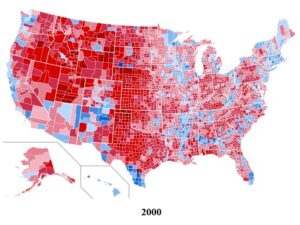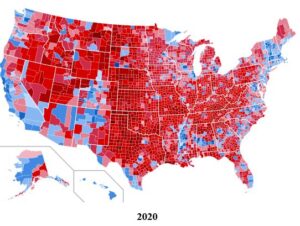Is Civil War in the U.S. Future?
In the previous Fifty Year Perspective blog post, the scatter-pattern map of red- and blue-colored counties representing 2020 presidential voting highlighted the political divisions within states. Blue-colored counties indicate more liberal populations, mostly urban areas, while red-colored counties indicate more conservative populations and more rural areas. All states except Oklahoma and West Virginia have counties of both colors.
Changes in voting patterns since the turn of the century are vividly revealed by a comparison of 2000 and 2020 county-level voting maps (as they appear in Wikimedia Commons). Numerous counties changed from blue to red, prominently in the Upper Midwest and along the course of the Mississippi River. Counties that had been light blue or light red became darker shades, signifying the increase in the winners’ margins in each county. Columnist Jamelle Bouie related the changes to conservative electorates’ pre-existing “anxieties, fears, anger, resentment, rage, about changing cultural and demographic facts about the country. It’s not just that the country is becoming less white, though that’s a part of it. But it’s also that the country is becoming less explicitly Christian, less explicitly deferential to Christian belief. It’s becoming more open and tolerant of different sexualities, different gender identities, different religions.”
Coincident with the changes in voting pattern, the intensity of polarization has unquestionably increased over the last two decades. Bouie’s comments came from a discussion involving him and author Tim Alberta titled “Is America Headed for Another Civil War?” Another Civil War is hard to reconcile with a map that looks like the 2020 election results. Instead, Alberta, who is a staff writer for The Atlantic magazine, foresees “some significant scale of semi-organized, lethal, civil conflict that is organized around not just political and ideological disputes, but perceived threats to economies, livelihoods,” and a “struggle for control of the existing state,” rather than overthrowing the state.
Alberta regarded the coronavirus pandemic as validating “the prophecy for so many on the right, of a hostile, weaponized, big government that was coming for them.” He saw the January 6 insurrection as a warning “that there are actual mechanisms within the system that one can leverage to secure minority control, to consolidate minority rule.”
The U.S. population in 2045 is projected to be less than 50% white for the first time, making the U.S. a majority-minority country. The “anxieties, fears, anger, resentment, [and] rage” are apparent in increasing white supremacy demonstrations, antisemitic violence and demonization of immigrants and refugees. Recently, passage of the CHIPS and Science Act to support the U.S. semiconductor industry was withheld until a provision boosting skilled immigration was removed.
What can be done to calm populist anxieties? Bouie, in the article, wrote that Republican politicians are “the only actors on this stage who have the agency to do something… They are the ones who have the ability to keep these things from spiraling out of control. The problem is that doing so would probably doom them in the next election cycles.”
In fact, some elected Republican officials are publicly supporting Democratic candidates in November 8, 2022 elections. Alaska’s Republican Senator plans to vote for the Democratic candidate for Alaska’s House seat. In Arizona, over two dozen current and former Republican elected officials support the Democratic candidate for Senate. Similarly, both current and former Republican elected officials support the Democratic candidate in Pennsylvania’s governor race.


